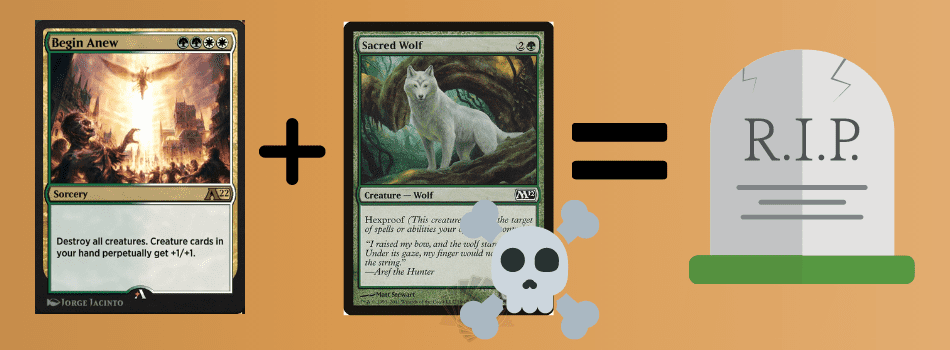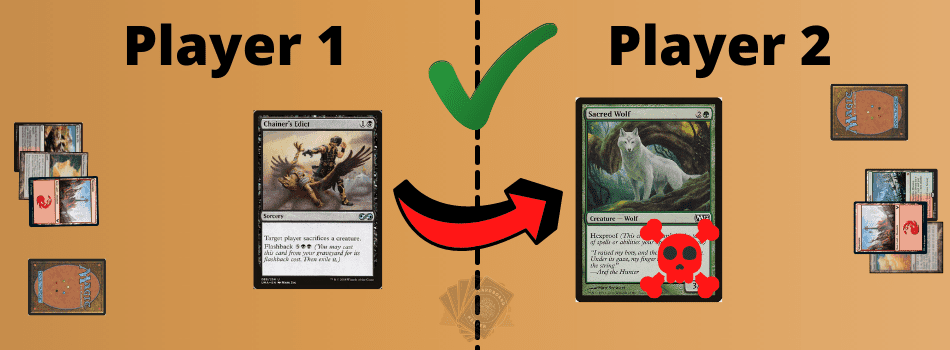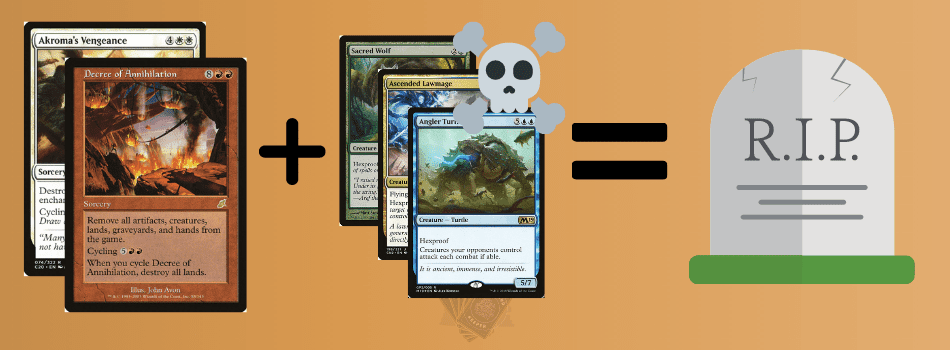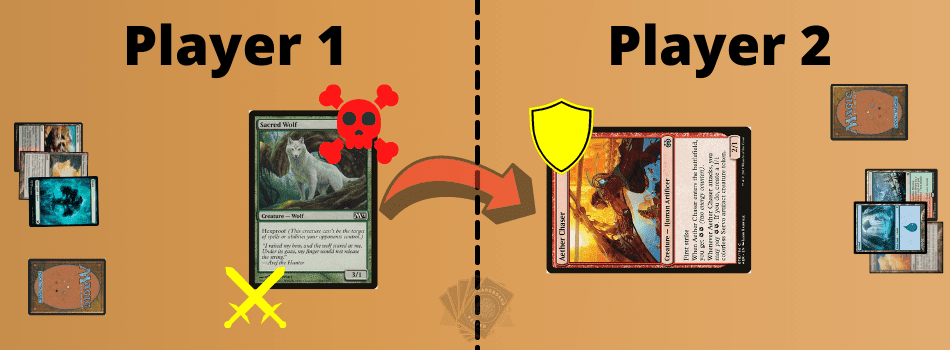Hexproof is an ability (mechanic) in MTG that can cause you a painful headache if you find your opponent’s deck focuses on their creatures using it. You may think that it’s almost impossible to remove creatures with this ability, and you are doomed to lose. However, there are a few ways around it.
Hexproof is mainly found on creature cards that protect them from targeted spells or abilities that an opponent controls. I.e., they can’t be damaged, destroyed, or exiled. However, it is not safe from combat damage (blocking/attacking) or non-specific abilities like “destroy all,” “exile all,” etc.
I cover and answer every question you may have regarding Hexproof in this article. What it does, how to use it, how to remove it, and how to counter it. I also give examples using actual cards to help explain each situation better.
- How Does Hexproof Work In MTG?
- Is Hexproof An Activated Ability?
- What Does Hexproof Protect Against?
- Does Hexproof Protect From Destroy All Creatures?
- What Can Destroy Hexproof?
- Can You Exile A Hexproof Card?
- Can Hexproof Be Board-Wiped?
- Can You Counter A Card With Hexproof?
- Hexproof Vs Shroud: Is Shroud The Same As Hexproof?
- Can You Block Hexproof?
- Hexproof Rules
- Conclusion
How Does Hexproof Work In MTG?
Hexproof is a mechanic (ability) in MTG that creatures can have or obtain.
As such, this ability can only affect creatures, players, and some other card types (Artifacts, enchantments, etc.). In essence, this mechanic protects cards from spells and abilities.
The official text for Hexproof reads, “This creature can’t be the target of spells or abilities your opponent’s control.”. The text
In simpler terms, a creature you control that has Hexproof can’t be given damage, destroyed, or have any other effects placed on it for the most part. Take into consideration that there are situations and cards that can affect and have this ability negated.
Is Hexproof An Activated Ability?
Hexproof is not an activated ability, it is a static ability.
This means that you do not have to pay any mana for it to be activated. However, you may have instants, sorceries, or abilities that grant Hexproof to a card, and you will have to pay the casting or ability cost for those spells to play them.
A static ability is an ability of an object that is always “on”, and cannot be turned “off”.

What Does Hexproof Protect Against?
Trying to understand the text whereby it states it can’t be the target of spells or abilities, let’s try to comprehend it better by looking at an example.
Sacred wolf has Hexproof. Thus, Shock will not be able to target it. However, if you have Sacred Wolf in play, you will be able to supplement it with Giant Growth.

Does Hexproof Protect From Destroy All Creatures?
Take into consideration that the mechanic’s text explicitly states “target.”
This means if you have a card such as Begin Anew because it does not expressly target one card, it will, in fact, destroy a card with Hexproof.
What Can Destroy Hexproof?
Considering cards that are not creatures, any card that does not specifically “target” a card and that can either exile or cause enough damage to reduce its toughness to zero will destroy a card with Hexproof.
For example, if you have Sacred Wolf and your opponent plays Aggravate, the one damage caused by it will cause Sacred Wolf to die.

Furthermore, cards that make you sacrifice a creature, such as Chainer’s Edict, will cause you to sacrifice a creature card you have that has Hexproof.
Note that this will only occur if you choose to sacrifice the card or if you have no other creature cards in play (then you will have to).
When it comes to combat, a creature card that has Hexproof can be blocked.
As such, if the resulting damage brings its toughness down to zero or less, then the card will die. For example, If Sacred Wolf attacks and is blocked by Broodmate Dragon, then it will die and be moved to the graveyard.

Can You Exile A Hexproof Card?
As long as you play a card that does not explicitly target a card with Hexproof, then, indeed, it can be exiled.
If the card states “exile all creatures” or “exile each creature,” then the creature card with Hexproof will be exiled.
For example, if you have Sacred Wolf and your opponent plays Divine Purge, then you will have to exile Sacred Wolf.
Can Hexproof Be Board-Wiped?
Board wipe cards are ones that typically don’t target any specific creature.
They usually say something along the lines of “destroy all creatures” or “remove all creatures from the battlefield” in some way.
Thus, because they do not specifically target a creature with Hexproof, once again, they will be subjected to the board wipe.

Let’s say you have Sacred Wolf, Angle Turtle, and Ascended Lawmage.
Your opponent then plays Akroma’s Vengeance (that will destroy) or Decree of Annihilation (that will remove). You will, in fact, lose all your creature cards with Hexproof, essentially wiping the board.
Out of all these examples, remember that the Hexproof ability will only apply if another card explicitly targets that card. Hexproof will be affected by any card if the text of that card’s ability is generalized and not specified.
Can You Counter A Card With Hexproof?
It will help if you remember that MTG works with a stack. In very simple terms, essentially, there is a chance for a response after a spell is cast. The card at the top of the stack will take priority, and its abilities will be considered first.

Thus, if you play a card with Hexproof and your opponent counters with a card like Anticognition, it will, in fact, be countered.
It would be best to understand that because your card with Hexproof has not actually resolved and made its way onto the battlefield, Anticognition’s ability will be prioritized. Thus, it will be countered.
However, if you have a card such as Cragplate Baloth, it actually has an ability that says, “this spell can’t be countered.” In this instance, this creature card will not be subjected to being countered, but this is not due to the card having Hexproof.
Hexproof Vs Shroud: Is Shroud The Same As Hexproof?
Hexproof has actually supplanted Shroud in that it made it obsolete in 2012.
Shroud had almost the same mechanic as Hexproof, although the ability also affected the controller (player) of the Shroud card. The official text stated:
This permanent or player can’t be the target of spells or abilities.
This differs from Hexproof. A card that is Hexproof can still be targeted by the control of that card, giving you the option to attached equipment or enchantments to it.
Shroud was mainly seen on blue and green cards with a few white as the exception. Shroud also spanned many permanents that were non-creature cards, such as artifact and equipment cards.
If you want more information on how the “Shroud” keyword works in Magic The Gathering, check out my guide on everything you need to know about Shroud.
ALSO READ: MTG Shroud: How Does It Work [Rules, Equipment, FAQ]

Can You Block Hexproof?
Creature cards that have Hexproof have the ability to be blocked by another creature card if they are attacking.
Remember that Hexproof deals with spells or abilities that specifically target it. The mechanic states nothing about combat, other creatures, blocking, or combat damage.
Hence, in all combat situations, if a card with Hexproof is attacking or blocking, it will die if its toughness is taken down to zero or less by another creature.
For example, if Sacred Wolf attacks and you block with Aether Chaser, Sacred Wolf will die. Also, in this example, take into consideration that Aether Chaser has First Strike. Nonetheless, if it did not, Sacred Wolf would still die.
Hexproof Rules
- 702.11a Hexproof is a static ability. (Source)
- 702.11b “Hexproof” on a permanent means “This permanent can’t be the target of spells or abilities your opponents control.”
- 702.11c “Hexproof” on a player means “You can’t be the target of spells or abilities your opponents control.”
- 702.11d Multiple instances of hexproof on the same permanent or player are redundant. (Source)
Conclusion
We discovered that Hexproof is a card ability (mechanic) that helps prevent it from being targeted by spells or abilities that your opponent controls. In essence, it protects it and makes it more difficult to remove.
Hexproof is mainly found on creature cards, but you do find spells, abilities, and other cards that have it or can grant it.
Then lastly, one of the ways to destroy or remove a card with Hexproof is to deal it combat damage (taking its toughness to zero). The other way is to remove it by using cards that don’t specifically target it but use more generalized terms such as “destroy all” or “exile all.”

